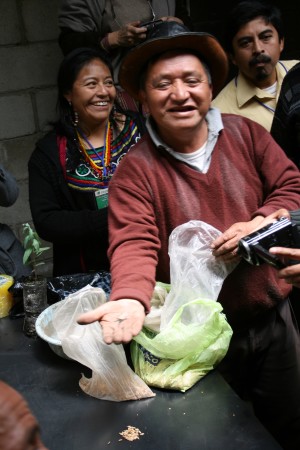
થી 17મી સુધી 27મી વિવિધ સેન્ટ્રલ અમેરિકન દેશોના સહભાગીઓ અને બે અત્યંત રોમાંચક મીટિંગમાં જ્ઞાન અને અનુભવો વહેંચ્યા.
આ પ્રથમ બેઠક સાંસ્કૃતિક ભૂમિકા પર ધ્યાન કેન્દ્રિત કર્યું, ટકાઉ વન વ્યવસ્થાપનમાં આધ્યાત્મિક અને પવિત્ર મૂલ્યો. આ બેઠક, દ્વારા આયોજિત Oxlajuj Ajpop, આ સેક્રેડ પ્રાકૃતિક સ્થળો પહેલ (SNSI) અને દ્વારા સમર્થિત કુદરતી ન્યાય ના વિકાસ પર ત્રણ સ્વદેશી સમુદાયોના સહભાગીઓને સક્ષમ બનાવવા માટે સેવા આપી હતી બાયોકલ્ચરલ કોમ્યુનિટી પ્રોટોકોલ્સ તેમના પવિત્ર કુદરતી સ્થળો અને જંગલોનું રક્ષણ કરવામાં મદદ કરવા માટેના સાધન તરીકે.
“પવિત્ર સ્થળો સમારોહના સ્થળો છે, લોકોની આધ્યાત્મિકતાનું કેન્દ્ર. તેથી તેમને ICCAs નું હૃદય તરીકે ઓળખવામાં લાંબો સમય લાગ્યો નથી” ગ્રાઝિયા બોરીની ફેયેરાબેન્ડ, ICCA કન્સોર્ટિયમના વૈશ્વિક સંયોજક.

નાની વસ્તુઓમાંથી મોટી વસ્તુઓ વધે છે. આ વાત સાચી છે, Totonicapan ના જાજરમાન જંગલો માટે પણ. અહીં ટ્રી નર્સરી સમુદાયના સભ્યો સમજાવે છે કે કેવી રીતે સ્થાનિક બીજની પસંદગી તેમના જંગલ માટે યોગ્ય એવા વૃક્ષો ઉગાડવામાં મદદ કરે છે.. સોર્સ: બાસ Verschuuren, 2013.
બીજી બેઠક ICCA કન્સોર્ટિયમની પ્રથમ પ્રાદેશિક બેઠક હતી જે ઓક્સલાજુજ અજપોપ દ્વારા સહ-આયોજિત કરવામાં આવી હતી., Ut'z ચે, tતે વૈશ્વિક વિવિધતા ફાઉન્ડેશન અને SNSI. પ્રદેશમાંથી સ્વદેશી અને સામુદાયિક સંરક્ષિત વિસ્તારો પર પ્રસ્તુતિઓની શ્રેણીમાં પરંપરાગત અનુભવોની સમૃદ્ધિ દર્શાવવામાં આવી હતી., ઇકોસિસ્ટમનો ઉપયોગ અને સંરક્ષણ અને શાસન:
– મેક્સિકોમાં Xpujil નો સ્વદેશી પ્રદેશ,
– ગ્વાટેમાલામાં પવિત્ર કુદરતી સ્થળોનું મહત્વ,
– કોસ્ટા રિકામાં દરિયાઈ સમુદાય તારકોલ્સને અનામત રાખે છે,
– પનામામાં કુનાનો સ્વદેશી પ્રદેશ,
– નિકારાગુઆમાં કાયદો અને માયાગ્ના,
– અલ સાલ્વાડોરમાં સ્વદેશી પ્રદેશો.
મધ્ય અમેરિકામાં મોટાભાગના ICCA ને અલગ-અલગ અને ઘણીવાર સ્થાનિક અથવા પ્રાદેશિક નામો હેઠળ સમજવામાં આવે છે તેમ છતાં સહભાગી સંમત થયા કે આ અનન્ય અને જૈવવિવિધ પ્રદેશોને સાચવવા માટે એક સામાન્ય યોજના અને વ્યૂહરચના ઘડવી જોઈએ..
લગભગ તમામ પ્રસ્તુતિઓએ સ્વદેશી અને સ્થાનિક સમુદાયોના પ્રદેશોમાં સ્થિત આધ્યાત્મિક સુખાકારીના સ્ત્રોત તરીકે પવિત્ર સ્થળોનો સંદર્ભ આપ્યો હતો.. મજબૂત ચઢાણ પછી, પ્રથમ મીટીંગના સહભાગીઓએ વિશાળ સમુદાય દ્વારા સંચાલિત જંગલો દ્વારા ઘેરાયેલ અને ટોટોનીકાપનની નજરે જોતા પર્વતની ટોચ પર સ્થિત સ્થાનિક પવિત્ર કુદરતીનો અનુભવ કર્યો.. પાછળથી દુ:ખદ સમાચાર આવ્યા કે પવિત્ર પ્રાકૃતિક સ્થળ અને તેની આસપાસના જંગલો પરિવારોને લણણી અને ખેતી કરવા માટે ફાળવવામાં આવ્યા છે કારણ કે તેઓ યોગ્ય લાગે છે..
આ પવિત્ર પ્રાકૃતિક સ્થળની શ્રદ્ધા એ ICCAs અને SNS નો સામનો કરતા જોખમોના ઘણા ઉદાહરણોમાંનું એક છે. કારણ કે આ સ્થાનો ઘણીવાર મારા મ્યુનિસિપલ પ્લાનર્સ અને એડમિનિસ્ટ્રેટર્સને પૂરતા પ્રમાણમાં ઓળખી શકાતા નથી જ્યારે સમુદાયની માલિકીનું કાનૂની શીર્ષક છીનવી લેવામાં આવે છે ત્યારે તેઓ ઘણીવાર ખોવાઈ જાય છે. વધુમાં, બેલગામ વનસંવર્ધન, ખાણકામ, શહેરીકરણ અને આંતરમાળખાકીય વિકાસ સમગ્ર પ્રદેશમાં જોખમોની યાદીમાં ઉચ્ચ સ્કોર ધરાવે છે. અન્ય ધમકીઓ વધુ ધીમે ધીમે વધવા માટે નોંધવામાં આવી હતી જેમ કે રાજ્ય શિક્ષણ અને ધાર્મિક રૂપાંતરણ જે લોકોના સ્વદેશી જ્ઞાન અને વિશ્વ દૃષ્ટિકોણને વ્યવસ્થિત રીતે દૂર કરે છે..

ઉપરથી પૃથ્વી! મુ 2700 મીટર એક પવિત્ર કુદરતી સ્થળનું ઔપચારિક કેન્દ્ર ટોટોનિકપાનના પ્રભાવશાળી દૃશ્યો આપે છે. જમણી બાજુના અગ્રભાગમાં તમે સ્થાનિક રહેવાસીઓને સામુદાયિક જંગલની ફાળવણીની અસર જોઈ શકો છો જેઓ લાકડા અને ખેતી માટે વૃક્ષો કાપવાનું પસંદ કરે છે.. મીટિંગના અંત પહેલા સહભાગીઓએ શીખ્યા કે સમુદાય શાસન હંમેશા યોગ્ય રીતે સન્માનિત નથી, તાજેતરમાં ફાળવણી કરવામાં આવી હતી જેમાં પવિત્ર કુદરતી સ્થળ સ્વરૂપનો સમાવેશ થાય છે જે આ છબી લેવામાં આવી હતી. સોર્સ: બાસ Verschuuren, 2013.
પડકારો હોવા છતાં બંને વર્કશોપના સહભાગીઓ તેમના અને તેમના પ્રદેશો સામેના દળોનો સામનો કરવા માટે ઉત્સાહિત અને પ્રેરિત હતા.. વકીલોના યોગ્ય જથ્થા દ્વારા સમર્થિત મીટિંગોએ સહભાગીઓને માત્ર આંતરરાષ્ટ્રીય પર્યાવરણીય અને માનવ અધિકાર કાયદા પર દૃષ્ટિકોણ મેળવવાની જ નહીં પરંતુ પ્રદેશમાંથી કેસ અને ન્યાયશાસ્ત્ર પર વિગતવાર માહિતી મેળવવાની પણ મંજૂરી આપી.. આમાંના મોટા ભાગનો સમુદાયો જે સમસ્યાઓનો સામનો કરે છે તેની સાથે સીધી સુસંગતતા ધરાવે છે અને ખાસ કરીને બાયોકલ્ચરલ કોમ્યુનિટી પ્રોટોકોલ્સને સમુદાયોના પરંપરાગત જ્ઞાનની રચના કરવાનું શરૂ કરવા માટેના પ્રથમ પગલા તરીકે જોવામાં આવે છે., ઉપયોગ, સ્થાનિકના માળખામાં મૂલ્યો અને અસ્કયામતો, રાષ્ટ્રીય અને આંતરરાષ્ટ્રીય કાયદો.
બાયોકલ્ચરલ કોમ્યુનિટી પ્રોટોકોલ્સ એ સમુદાયની તમામ સમસ્યાઓના નિરાકરણ માટેનો ઉપાય નથી.. જો કે આંતરરાષ્ટ્રીય કાયદામાં તેનો ઉલ્લેખ કરવામાં આવ્યો છે અને જ્યારે સ્થાનિક સમુદાયો દ્વારા શરૂ અને વિકસિત કરવામાં આવે છે ત્યારે તેઓ સમુદાયને અંદરથી મજબૂત કરવા અને બહારના લોકો સાથે તેમના હિતોની વાટાઘાટો કરવા માટે એક મહત્વપૂર્ણ સાધન બની શકે છે.. એલી મકોગોન, કુદરતી ન્યાય સાથે આંતરરાષ્ટ્રીય પર્યાવરણ વકીલ.






